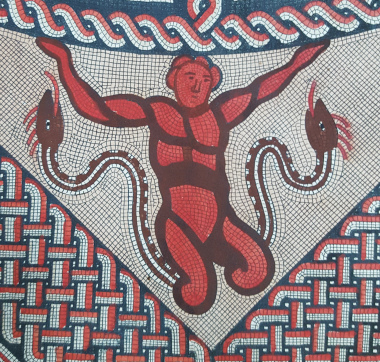Charging at Giants in Lincolnshire by Jim Snee

There is, and always has been, something quixotic about the heritage profession.
Cervantes’ famous knight (Don Quixote) charged at windmills believing them to be giants. In heritage, it sometimes feels that in order to preserve windmills, we must turn them into giants.
But is there a tradition of giants in Lincolnshire?
Although the earliest written records of British mythology date to the Anglo-Saxon period, scholars are confident that these include retellings of much earlier stories. The Welsh and Irish mythological cycles are believed to have elements dating back to the prehistoric, with references to a “great deluge” that may have been the flooding of the land bridge between Britain and the Continent at the end on the last period of glaciation (Some call this the last Ice Age, but technically we are still in that). Legends from the British Isles and the continent describe the lands that were lost in idealistic terms, a land of plenty inhabited by heroic giants and beautiful women.
Another ‘early’ source of British giants comes from the story of Brutus of Troy. An extension of the Roman legend of Aeneas and the founding of Rome, Brutus is an exodus story that redeems the enslaved survivors of Troy and takes them through a series of trials before settling them in Britain. On arrival, they find the land inhabited by giants descended from Albion, the legendary son of Poseidon.
So, as with many things, we see remarkable consistency of theme in ancient mythology across the whole of Europe. That isn’t to say that it is true, but it does re-enforce the idea that our ancient ancestors were not so culturally isolated as some historical accounts would have us believe.
In the Roman period, we find the first representations of giants in Lincolnshire itself. In 1797, labourers working in the grounds of Horkstow Hall discovered a large floor mosaic. Two drawings were made, and both show the overall layout and the figures in the corners. These figures are strange characters with well-defined muscular bodies, but they have legs that from the knee become snakes. This mythological beast, known as an Anguiped, was commonly used by the Roman’s to depict the giants that waged war upon the gods for control of the universe. It is a mythological figure associated particularly with the Middle East and again reinforces the idea of a common mythology stretching from Britain in the west, possibly as far as India in the east. In 2009, a bronze figurine of Roman date was found near Caenby Corner. This was another Anguiped, that appeared to kneel in a gesture of submission (head turned up, right hand raised). A possible third Roman depiction of a giant has been reported from Ancaster, although only the head is present. Overall, however, it would appear that it was an image known to the inhabitants of Roman Lincolnshire.
To find Anglo-Saxon giants, we look to a very different source of information; place names. The Old English word ‘thyrs’ means giant or ogre and can be found in place names across the county. For example, there is a Thurspit in Alvingham, and a Thyrspittes in Foston (giant’s pits), and a Thruswelker in Stallingborough that would be a marsh inhabited by giants.
In the medieval period, giants seem to have gone out of style somewhat, replaced by smaller creatures such as hobs and shuck. Medieval manuscripts tend to refer to giants having either lived a long time ago, or in very distant lands. Giants are occasionally included in mummers plays, but more often the character of Jack the giant killer (a dwarf with mighty strength and a wooden club) is found, boasting that all the giants are slain.
In the post-medieval and industrial eras a new kind of giant appeared, either the abstract giant of collective force, or mechanical giants in the form of pumps and engines. However, another form of lesser giant was also appearing at court entertainments and later fairs and circuses.
‘The world’s tallest man’ was usually an individual suffering from gigantism – a condition that causes abnormal growth. Such individuals would have existed throughout the centuries, but their use as entertainment is really only documented from the 16th century onwards. The most famous era for such shows was the 19th century, and as well as genuinely huge individuals, there were often stilt walkers and other enhanced individuals presented in cheap sideshows. No doubt Lincolnshire had its fair share of both.
Today individuals with gigantism are treated by the medical profession and their growth controlled to a level where they can maintain a healthy lifestyle. Giants are the stuff of storybooks and movie magic.
As for the windmills? A few remain, and there are devoted volunteers who work to ensure that they will be with us for some time to come.
After all, they might be giants…
